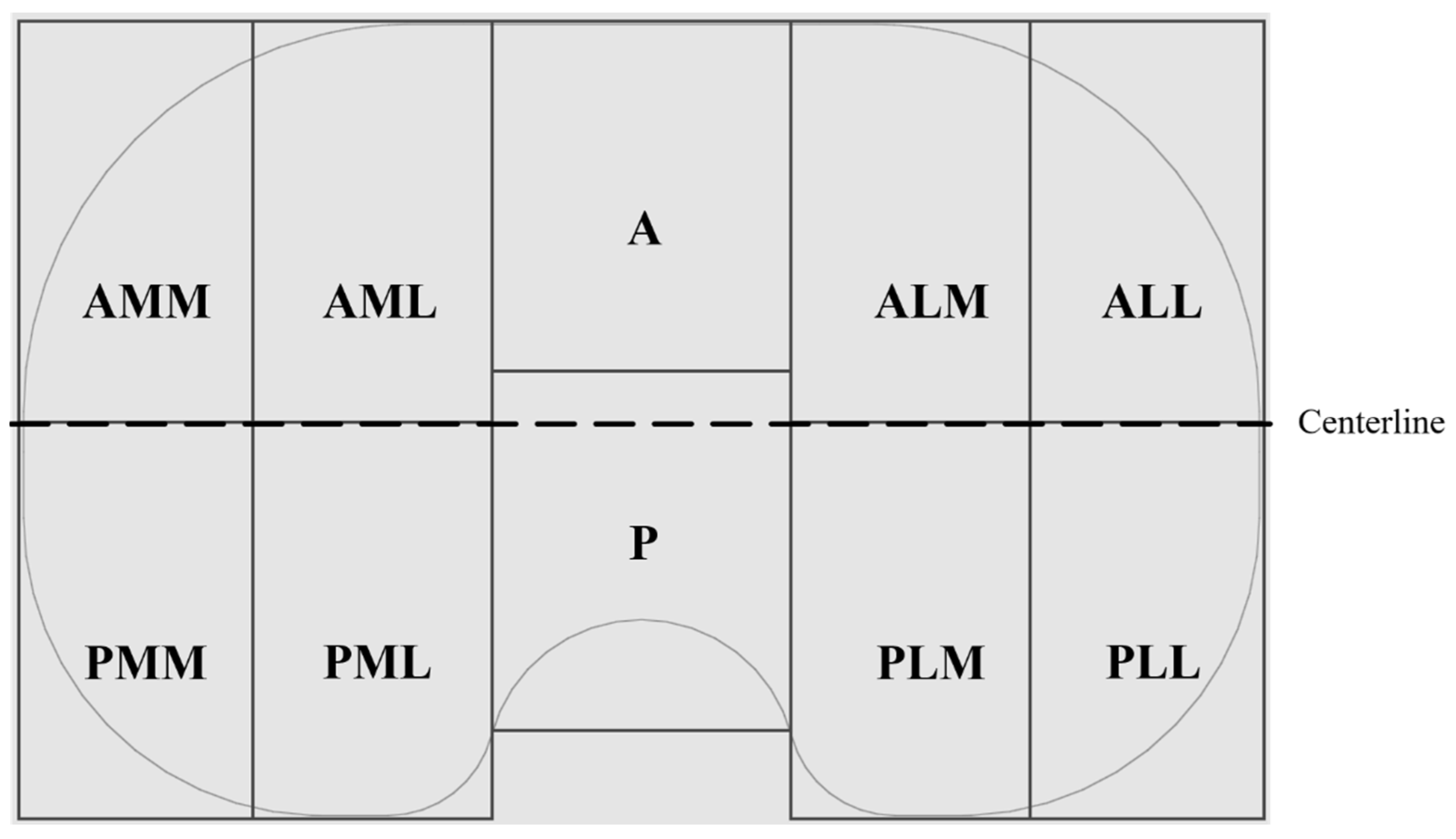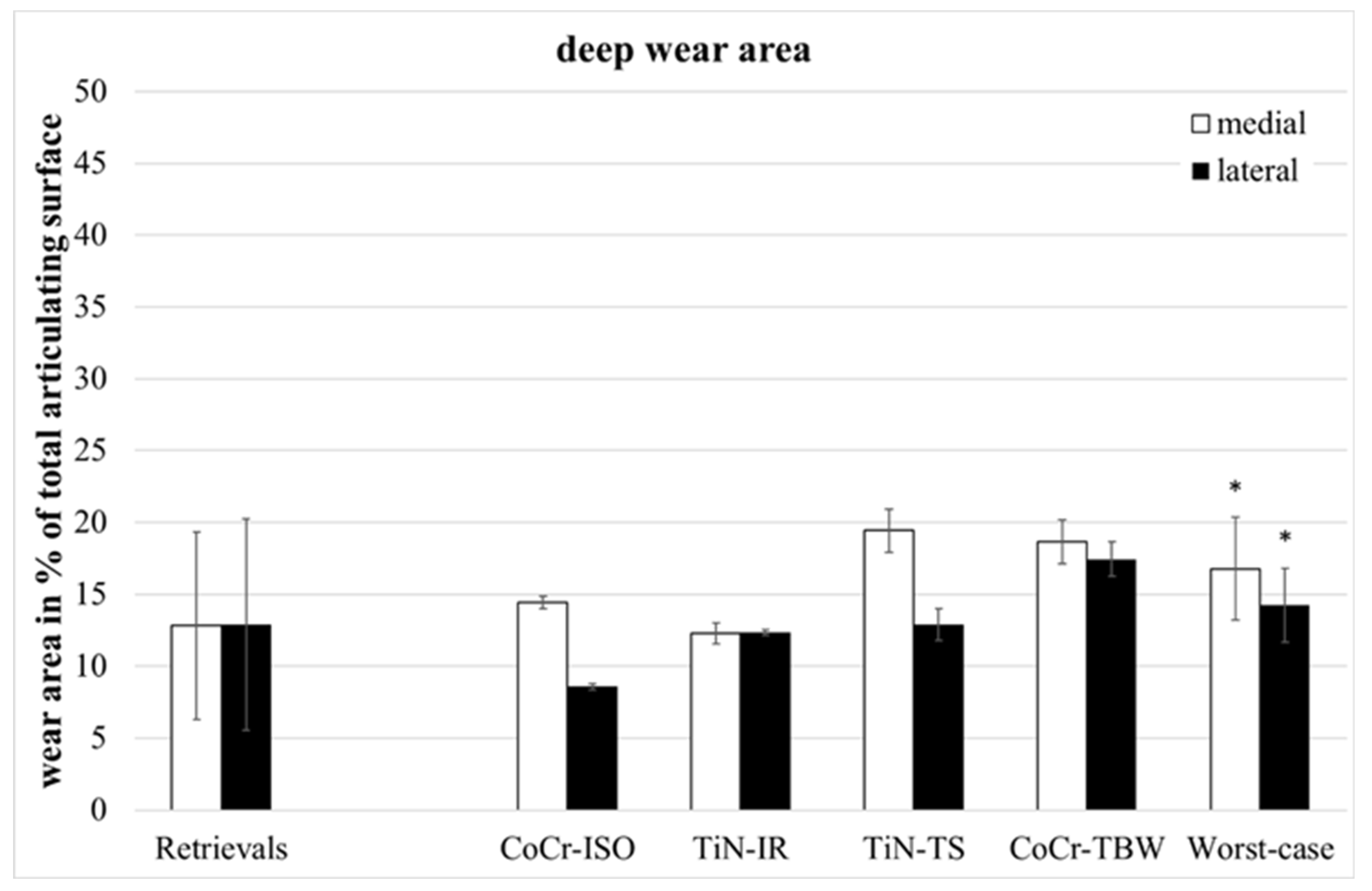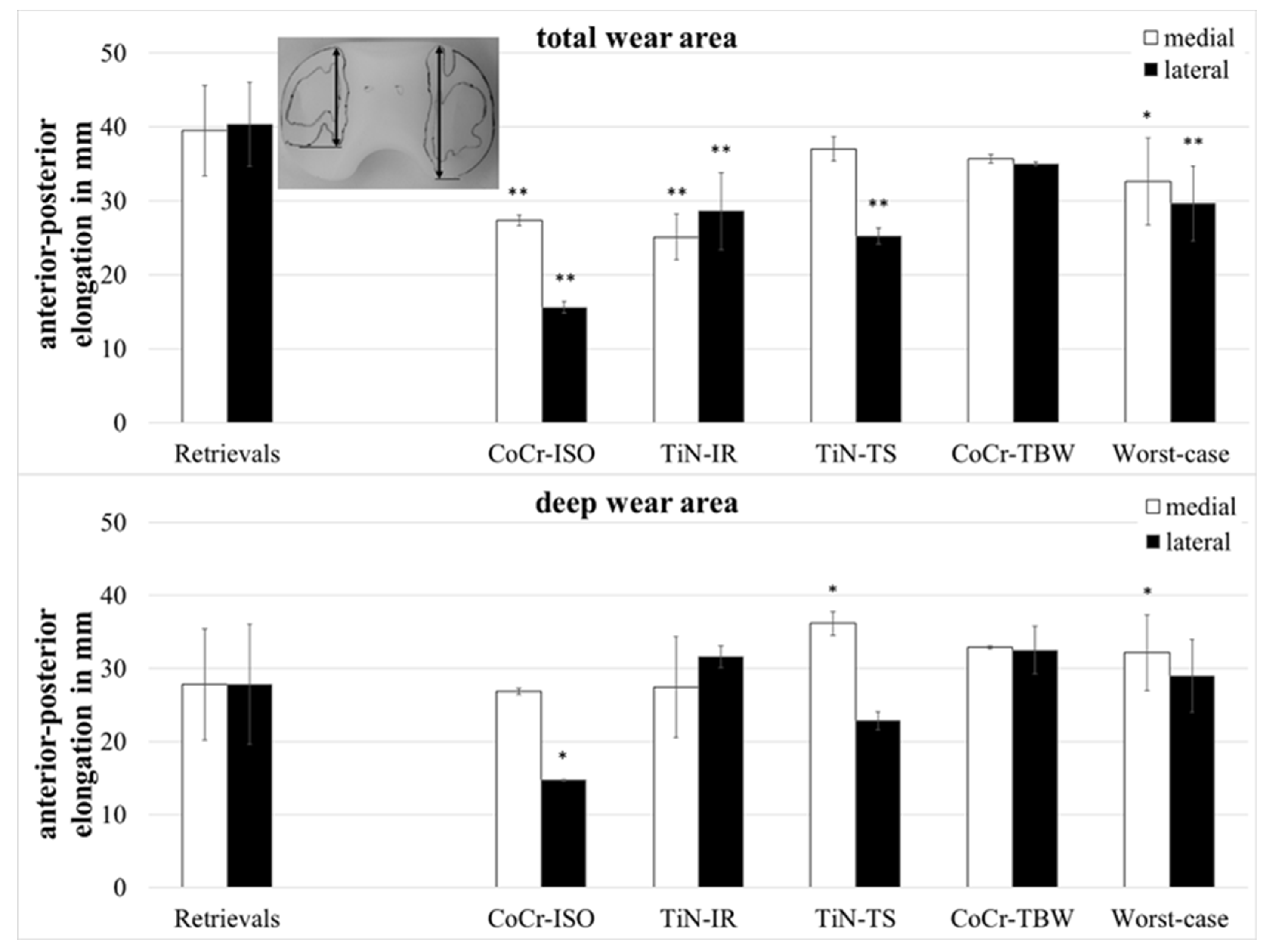A Comparison of Wear Patterns on Retrieved and Simulator-Tested Total Knee Replacements
Abstract
1. Introduction
2. Materials and Methods
2.1. Implant Components
2.2. Wear Simulator Study
2.3. Retrieval Analysis
2.4. Examination of Wear Area and Patterns
2.4.1. Wear Area
2.4.2. Wear Patterns
2.5. Statistical Analysis
3. Results
3.1. Wear Areas (in %)
3.2. Dimension of Wear Areas (in mm)
3.3. Microscopic Examination
4. Discussion
5. Conclusions
- Deep wear zones could be better replicated according to the in vivo situation based on the third body wear simulation compared with other wear test conditions, despite similar in situ times of the retrieved and the simulator tested inserts (according to Battenberg et al. [31]).
- Pitting and TBW, the most prevalent wear patterns in the retrievals, could not be reproduced in the standard wear simulator test but could be replicated in the worst-case wear test conditions.
- Single rim-runners were detected on all the retrievals but could not be reproduced in the standard wear simulator tests; they were detected only in tibial sloped and internal rotated simulations.
Author Contributions
Funding
Institutional Review Board Statement
Informed Consent Statement
Data Availability Statement
Acknowledgments
Conflicts of Interest
References
- The German Arthroplasty Registry (EPRD). Annual Report 2021; EPRD, German Arthroplasty Registry gGmbH: Berlin, Germany, 2021. [Google Scholar] [CrossRef]
- Swedish Knee Arthroplasty Register. Annual Report 2020; Swedish Knee Arthroplasty Register: Lund University, Department of Clinical Sciences, Orthopedics, Skåne University Hospital: Lund, Sweden, 2020; ISBN 978-91-88017-32-1. [Google Scholar]
- Civinini, R. The Survival of Total Knee Arthroplasty: Current Data from Registries on Tribology. HSS J. 2017, 13, 28–31. [Google Scholar] [CrossRef]
- Tarwala, R.; Dorr, L.D. Septic Revision Knee Arthroplasty–U.S. Experience. In Revisionsendoprothetik des Kniegelenks; Trieb, K., Heller, K.-D., Wirtz, D.C., Eds.; Springer: Berlin/Heidelberg, Germany, 2011. [Google Scholar] [CrossRef]
- Gallo, J.; Goodman, S.; Konttinen, Y.; Raska, M. Particle disease: Biologic mechanisms of periprosthetic osteolysis in total hip arthroplasty. Innate Immun. 2013, 19, 213–224. [Google Scholar] [CrossRef] [PubMed]
- Swedish Arthroplasty Register. Annual Report 2021; Swedish Arthroplasty Register: Göteborg, Sweden, 2021; ISBN 978-91-986612-1-7. [Google Scholar]
- Hood, R.W.; Wright, T.M.; Burstein, A.H. Retrieval analysis of total knee prostheses: A method and its application to 48 total condylar prostheses. J. Biomed. Mater. Res. 1983, 17, 829–842. [Google Scholar] [CrossRef] [PubMed]
- Revell, P.A.; Al-Saffar, N.; Kobayashi, A. Biological reaction to debris in relation to joint prostheses. Proc. Inst. Mech. Eng. Part H J. Eng. Med. 1997, 211, 187–197. [Google Scholar] [CrossRef] [PubMed]
- Wimmer, M.A.; Andriacchi, T.R.; Natarajan, R.N.; Loos, J.; Karlhuber, M.; Petermann, J.; Schneider, E.; Rosenberg, A.G. A Striated Pattern of Wear in Ultrahigh-molecular-weight Polyethylene Components of Miller-Galante Total Knee Arthroplasty Material. J. Arthroplast. 1998, 13, 8–16. [Google Scholar] [CrossRef]
- Otto, M. Klassifikation bei Prothesen—Insuffizienz und Partikelbestimmung. Pathologe 2008, 29, 232–239. [Google Scholar] [CrossRef]
- Fisher, J.; Bell, J.; Barbour, P.S.M.; Tipper, J.L.; Matthews, J.B.; Besong, A.A.; Stone, M.H.; Ingham, E. A novel method for the prediction of functional biological activity of polyethylene wear debris. Proc. Inst. Mech. Eng. Part H J. Eng. Med. 2000, 215, 127–132. [Google Scholar] [CrossRef] [PubMed]
- ISO 14242-1:2012; Implants for Surgery—Wear of Total Hip-Joint Prostheses—Part 1: Loading and Displacement Parameters for Wear-Testing Machines and Corresponding Environmental Conditions for Test. International Organization for Standardization: Geneva, Switzerland, 2012.
- ISO 14242-3:2009; Implants for Surgery—Wear of Total Hip-Joint Prostheses—Part 3: Loading and Displacement Parameters for Orbital Bearing Type Wear Testing Machines and Corresponding Environmental Conditions for Test. International Organization for Standardization: Geneva, Switzerland, 2009.
- ISO 14243-1:2009; Implants for Surgery—Wear of Total Knee-Joint Prostheses—Part 1: Loading and Displacement Parameters for Wear-Testing Machines with Load Control and Corresponding Environmental Conditions for Test. International Organization for Standardization: Geneva, Switzerland, 2009.
- ISO 14243-3:2004; Implants for Surgery—Wear of Total Knee-Joint Prostheses—Part 3: Loading and Displacement Parameters for Wear-Testing Machines with Displacement Control and Corresponding Environmental Conditions for Test. International Organization for Standardization: Geneva, Switzerland, 2004.
- Australian Orthopaedic Association; National Joint Replacement Registry (AOANJRR). Hip, Knee & Shoulder Arthroplasty: 2021 Annual Report; Australian Orthopaedic Association: Adelaide, SA, Australia, 2021. [Google Scholar]
- Zietz, C.; Fabry, C.; Reinders, J.; Dammer, R.; Kretzer, J.; Bader, R.; Sonntag, R. Wear testing of total hip replacements under severe conditions. Expert Rev. Med. Devices 2015, 12, 393–410. [Google Scholar] [CrossRef] [PubMed]
- Dowling, J.; Atkinson, J.; Dowson, D.; Charnley, J. The Characteristics of acetabular cups worn in the human body. J. Bone Jt. Surg. 1978, 60-B, 375–382. [Google Scholar] [CrossRef]
- Harman, M.; Affatato, S.; Spinelli, M.; Zavalloni, M.; Stea, S.; Toni, A. Polyethylene insert damage in unicondylar knee replacement: A comparison of in vivo function and in vitro simulation. Proc. Inst. Mech. Eng. Part H J. Eng. Med. 2010, 224, 823–830. [Google Scholar] [CrossRef] [PubMed]
- Rawlinson, J.; Furman, B.; Li, S.; Wright, T.; Bartel, D. Retrieval, Experimental, and Computational Assessment of the Performance of Total Knee Replacements. J. Orthop. Res. 2006, 24, 1384–1394. [Google Scholar] [CrossRef]
- Harman, M.; Desjardins, J.; Benson, L.; Banks, S.; Laberge, M.; Hodge, W. Comparison of Polyethylene Tibial Insert Damage from In Vivo Function and In Vitro Wear Simulation. J. Orthop. Res. 2009, 27, 540–548. [Google Scholar] [CrossRef] [PubMed]
- Zietz, C.; Reinders, J.; Schwiesau, J.; Paulus, A.; Kretzer, J.; Grupp, T.; Utzschneider, S.; Bader, R. Experimental testing of total knee replacements with UHMW-PE inserts: Impact of severe wear test conditions. J. Mater. Sci. Mater. Med. 2015, 26, 134. [Google Scholar] [CrossRef] [PubMed]
- Villaseñor, D.A.O.; Wimmer, M.A. Wear Scar Similarities between Retrieved and Simulator-Tested Polyethylene TKR Components: An Artificial Neural Network Approach. BioMed Res. Int. 2016, 2016, 2071945. [Google Scholar] [CrossRef] [PubMed]
- Fabry, C.; Zietz, C.; Dammer, R.; Bader, R. Patterns of Wear in Total Knee Replacement. In The Unhappy Total Knee Replacement; Springer International Publishing: Cham, Switzerland, 2015. [Google Scholar] [CrossRef]
- Wasielewski, R.; Galante, J.; Leighty, R.; Natarajan, R.; Rosenberg, A. Wear Patterns on Retrieved Polyethylene Tibial Inserts and Their Relationship to Technical Considerations During Total Knee Arthroplasty. Clin. Orthop. Relat. Res. 1994, 299, 31–43. [Google Scholar] [CrossRef]
- Tamura, J.; Clarke, I.; Kawanabe, K.; Akagi, M.; Good, V.; Williams, P.; Masaoka, T.; Schroeder, D.; Oonishi, H. Micro-wear patterns on UHMWPE tibial inserts in total knee joint simulation. J. Biomed. Mater. Res. 2002, 61, 218–225. [Google Scholar] [CrossRef] [PubMed]
- Manescu, V.; Antoniac, I.; Antoniac, A.; Paltanea, G.; Miculescu, M.; Bita, A.-I.; Laptoiu, S.; Niculescu, M.; Stere, A.; Paun, C.; et al. Failure Analysis of Ultra-High Molecular Weight Polyethylene Tibial Insert in Total Knee Arthroplasty. Materials 2022, 15, 7102. [Google Scholar] [CrossRef] [PubMed]
- Pruitt, L.A. Deformation, yielding, fracture and fatigue behavior of conventional and highly cross-linked ultra high molecular weight polyethylene. Biomaterials 2005, 26, 905–915. [Google Scholar] [CrossRef] [PubMed]
- Zietz, C.; Bergschmidt, P.; Lange, R.; Mittelmeier, W.; Bader, R. Third-body abrasive wear of tibial polyethylene inserts combined with metallic and ceramic femoral components in a knee simulator study. Int. J. Artif. Organs 2013, 36, 47–55. [Google Scholar] [CrossRef] [PubMed]
- Zietz, C.; Dempwolf, H.; Dammer, R.; Mick, E.; Bader, R. Wear Simulator Study of Total Knee Replacement with Increased Kinematic Test Conditions. ESB-Congress, Prague, Poland 2015. Available online: https://www.czech-in.org/cm/ESB/CM.NET.WebUI/CM.NET.WEBUI.scpr/SCPRfunctiondetail.aspx?confID=05000000-0000-0000-0000-000000000056&sesID=05000000-0000-0000-0000-000000003560&absID=07000000-0000-0000-0000-000000023249 (accessed on 18 November 2022).
- Battenberg, A.; Hopkins, J.; Kupiec, A.; Schmalzried, T. The 2012 Frank Stinchfield Award. Clin. Orthop. Relat. Res. 2013, 471, 386–392. [Google Scholar] [CrossRef] [PubMed]
- Wright, T.M.; Goodman, S. (Eds.) Material and design considerations—What are the wear mechanisms and what controls them? In Proceedings of the Implant Wear in Total Joint Replacement: Symposium, Oakbrook, IL, USA, 21–23 October 2000; American Academy of Orthopaedic Surgeons: Rosemont, IL, USA, 2001; pp. 176–185. [Google Scholar]
- Wright, T.; Rimnac, C.; Stulberg, S.; Mintz, L.; Tsao, A.; Klein, R.; McCrae, C. Wear of Polyethylene in Total Joint Replacements—Observations from Retrieved PCA Knee Implants. Clin. Orthop. Relat. Res. 1992, 276, 126–134. [Google Scholar] [CrossRef]
- Cornwall, G.B.; Bryant, J.T.; Hansson, C.M.; Rudan, J.; Kennedy, L.A.; Cooke, T.D.V. A Quantitative Technique for Reporting Surface Degradation Patterns of UHMWPE Components of Retrieved Total Knee Replacements. J. Appl. Biomater. 1995, 6, 9–18. [Google Scholar] [CrossRef]
- Hossain, F.; Patel, S.; Haddad, F. Midterm Assessment of Causes and Results of Revision Total Knee Arthroplasty. Clin. Orthop. Relat. Res. 2010, 468, 1221–1228. [Google Scholar] [CrossRef] [PubMed]
- Mabry, T.M.; Vessely, M.B.; Schleck, C.D.; Harmsen, W.S.; Berry, D.J. Revision Total Knee Arthroplasty with Modular Cemented Stems. J. Arthroplast. 2007, 22, 100–105. [Google Scholar] [CrossRef] [PubMed]
- Bae, D.K.; Song, S.J.; Heo, D.B.; Lee, S.H.; Song, W.J. Long-term Survival Rate of Implants and Modes of Failure After Revision Total Knee Arthroplasty by a Single Surgeon. J. Arthroplast. 2013, 28, 1130–1134. [Google Scholar] [CrossRef] [PubMed]
- Morlock, M.; Schneider, E.; Bluhm, A.; Vollmer, M.; Bergmann, G. Duration and frequency of every day activities in total hip patients. J. Biomech. 2001, 34, 873–881. [Google Scholar] [CrossRef]
- Keller, R.; Amis, A. Anatomy and Biomechanics of the Natural Knee and After TKR. In The Unhappy Total Knee Replacement; Springer International Publishing: Cham, Switzerland, 2015; pp. 3–15. [Google Scholar]
- Pourzal, R.; Cip, J.; Rad, E.; Laurent, M.P.; Berger, R.A.; Jacobs, J.J.; Wimmer, M.A. Joint Line Elevation and Tibial Slope are associated with increased Polyethylene Wear in Cruciate Retaining Total Knee Replacement. J. Orthop. Res. 2021, 38, 1596–1606. [Google Scholar] [CrossRef]
- Williams, D.; Metcalfe, A.; Madete, J.; Whatling, G.; Kempshall, P.; Forster, M.; Lyons, K.; Holt, C. The relationship between alignment, function and loading in total knee replacement: In-vivo analysis of a unique patient population. J. Biomech. 2020, 112, 110042. [Google Scholar] [CrossRef] [PubMed]
- Fitzpatrick, C.K.; Clary, C.W.; Laz, P.J.; Rullkoetter, P.J. Relative Contributions of Design, Alignment, and Loading Variability in Knee Replacement Mechanics. J. Orthop. Res. 2012, 30, 2015–2024. [Google Scholar] [CrossRef]
- Laura, A.; Reyna, P.; Jäger, M.; Floerkemeier, T.; Frecher, S.; Delank, K.; Schilling, C.; Grupp, T.M. Backside Wear Analysis of Retrieved Acetabular Liners with a Press-Fit Locking Mechanism in Comparison to Wear Simulation In Vitro. Biomed. Res. Int. 2016, 2016, 8687131. [Google Scholar]
- Medel, F.J.; Kurtz, S.M.; Parvizi, J.; Klein, G.R.; Kraay, M.J.; Rimnac, C.M. In Vivo Oxidation Contributes to Delamination but not Pitting in Polyethylene Components for Total Knee Arthroplasty. J. Arthroplast. 2011, 26, 802–810. [Google Scholar] [CrossRef] [PubMed]
- Berend, M.E.; Davis, P.J.; Ritter, M.A.; Keating, E.M.; Faris, P.M.; Meding, J.B.; Malinzak, R.A. “Thicker” Polyethylene Bearings Are Associated with Higher Failure Rates in Primary Total Knee Arthroplasty. J. Arthroplast. 2010, 25, 17–20. [Google Scholar] [CrossRef] [PubMed]
- Mcgloughlin, T.M.; Kavanagh, A.G. Wear of ultra-high molecular weight polyethylene (UHMWPE) in total knee prostheses: A review of key influences. Proc. Inst. Mech. Eng. Part H J. Eng. Med. 2000, 214, 349–359. [Google Scholar] [CrossRef] [PubMed]
- Crowninshield, R.D.; Wimmer, M.A.; Jacobs, J.J.; Rosenberg, A.G. Clinical Performance of Contemporary Tibial Polyethylene Components. J. Arthroplast. 2006, 21, 754–761. [Google Scholar] [CrossRef] [PubMed]








| Test Condition | Standard Wear Test, ISO 14243-1 | Worst-Case Tests | ||
|---|---|---|---|---|
| Internal Rotation (IR) of Femoral Component of 9° | Posterior Tibial Slope (TS) of 10° | Third-Body-Wear (TBW) | ||
| Femoral component | Co28Cr6Mo (1) | Co28Cr6Mo and TiN (2) coating | Co28Cr6Mo and TiN (2) coating | Co28Cr6Mo (1) |
| Time In Situ in Years | Total Wear in % | Superficial Wear in % | Deep Wear Area in % | Damage Score | Wear Pattern | |||
|---|---|---|---|---|---|---|---|---|
| 1. | 2. | Further | ||||||
| Retrievals (n = 21) | 1.9 ± 1.9 | 52.3 ± 11.7 | 29.6 ± 10.3 | 22.6 ± 12.8 | 32.7 ± 5.9 | scratching | pitting TBW | rim-runner, burnishing, abrasion |
| CoCr-ISO (n = 3) | 2.5 (1) | 23.9 ± 1.1 | 0.8 ± 0.9 | 24.6 ± 0.9 | 22.7 ± 1.5 | burnishing, abrasion, scratching | striated wear pattern | - |
| TiN-IR (n = 3) | 1.2 (1) | 27.4 ± 1.0 | 2.8 ± 0.6 | 24.6 ± 0.9 | 29.2 ± 4.9 | scratching | burnishing, abrasion | striated wear pattern,rim-runner |
| TiN-TS (n = 3) | 1.5 (1) | 34.3 ± 2.4 | 1.9 ± 0.8 | 32.4 ± 2.3 | 30.5 ± 3.0 | burnishing, abrasion, scratching | striated wear pattern, deformation | rim-runner |
| CoCr-TBW (n = 3) | 2.5 (1) | 42.1 ± 1.1 | 6.0 ± 2.0 | 36.1 ± 1.6 | 35.0 ± 1.8 | abrasion, scratching | TBW | pitting |
| Worst-case (n = 12) | 1.7 ± 0.6 (1) | 34.6 ± 6.5 | 3.6 ± 2.2 | 31.0 ± 5.3 | 32.0 ± 4.0 | abrasion, scratching | burnishing | striated wear pattern, deformation |
Publisher’s Note: MDPI stays neutral with regard to jurisdictional claims in published maps and institutional affiliations. |
© 2022 by the authors. Licensee MDPI, Basel, Switzerland. This article is an open access article distributed under the terms and conditions of the Creative Commons Attribution (CC BY) license (https://creativecommons.org/licenses/by/4.0/).
Share and Cite
Dammer, R.H.; Zietz, C.; Bader, R. A Comparison of Wear Patterns on Retrieved and Simulator-Tested Total Knee Replacements. J. Funct. Biomater. 2022, 13, 256. https://doi.org/10.3390/jfb13040256
Dammer RH, Zietz C, Bader R. A Comparison of Wear Patterns on Retrieved and Simulator-Tested Total Knee Replacements. Journal of Functional Biomaterials. 2022; 13(4):256. https://doi.org/10.3390/jfb13040256
Chicago/Turabian StyleDammer, Rebecca H., Carmen Zietz, and Rainer Bader. 2022. "A Comparison of Wear Patterns on Retrieved and Simulator-Tested Total Knee Replacements" Journal of Functional Biomaterials 13, no. 4: 256. https://doi.org/10.3390/jfb13040256
APA StyleDammer, R. H., Zietz, C., & Bader, R. (2022). A Comparison of Wear Patterns on Retrieved and Simulator-Tested Total Knee Replacements. Journal of Functional Biomaterials, 13(4), 256. https://doi.org/10.3390/jfb13040256







